Iceland offers an abundance of breathtaking natural attractions. Iceland’s magical South Coast, or “Suðurland” in the local language, has dramatic landscapes worth your time. Thankfully, Iceland no longer has Covid-related border restrictions.
Touring South Iceland
The South Coast is easily accessible from Reykjavik, Iceland’s capital, thanks to the Ring Road. A private day trip from Reykjavik will take you about 10 to 12 hours, with stops at major waterfalls and beaches. The duration depends on how you wish to enjoy the attractions. Daylight hours are longer during the summer months, allowing you to enjoy a lot more during a day trip.
If you want to enjoy a lot more, you could break up the day trip with an overnight stay at Hvolsvöllur or Höfn, or elsewhere along the South Coast. This gives you an opportunity to explore other awesome attractions in southern Iceland that are not necessarily along the coast.
To see all the attractions, plan for 2 to 4 days of exploring. Depending on your interests, you may add such experiences as guided hikes and horse riding across glaciers and through the landscapes of Landmannalaugar or Thorsmork.
The famous Golden Circle has numerous stunning sites along the extended coastline. The roads lead close to Katla, Hekla, and Eyjajfjallajökull volcanos, charming villages, craggy mountains, rural farms, and otherworldly lava fields.

Top Places to See Along the Way in South Iceland
Heiðmörk Nature Reserve
Heiðmörk Nature Reserve lies just a few kilometers outside the capital. You get to see Rauðhólar, which are distinct, eye-catching volcanic red hills with strange shapes. Other activities available at the Nature Reserve are exploring the Mariuhellar caves, cycling, hiking, and horse riding.
Hellisheiði Geothermal Power Plant & Exhibition
Visit the Hellisheiði, the third-largest geothermal power station in the world, to see how a modern power plant can operate sustainably. This sprawling site provides almost a third of the total electricity and hot water for all of Iceland. There is an exhibition where you will learn about renewable and green energy sources, complete with informative and interesting multimedia displays.
Reykjadalur Valley Thermal River & Hot Springs
The Reykjadalur valley, nicknamed the Smoky Valley, is nestled in the Hengill Mountains. This is an active geothermal area featuring hot springs and a river that is enticingly warm. You can have a relaxing dip or walk along the river. The water is hotter upstream.
Seljalandsfoss & Gljúfrabúi Waterfalls
A visit to the Seljalandsfoss waterfall is often the highlight when exploring the South Coast of Iceland. The waterfall is located in the shadow of the Eyjafjallajökull volcano, with water flowing down from the volcano to feed the waterfall. There is a path behind the cascade if you want to see the waterfalls from different perspectives.
Just a short stroll from the Seljalandsfoss waterfall is the secluded Gljúfrabúi Waterfall, a pretty waterfall that flows through a crack in the rocks.
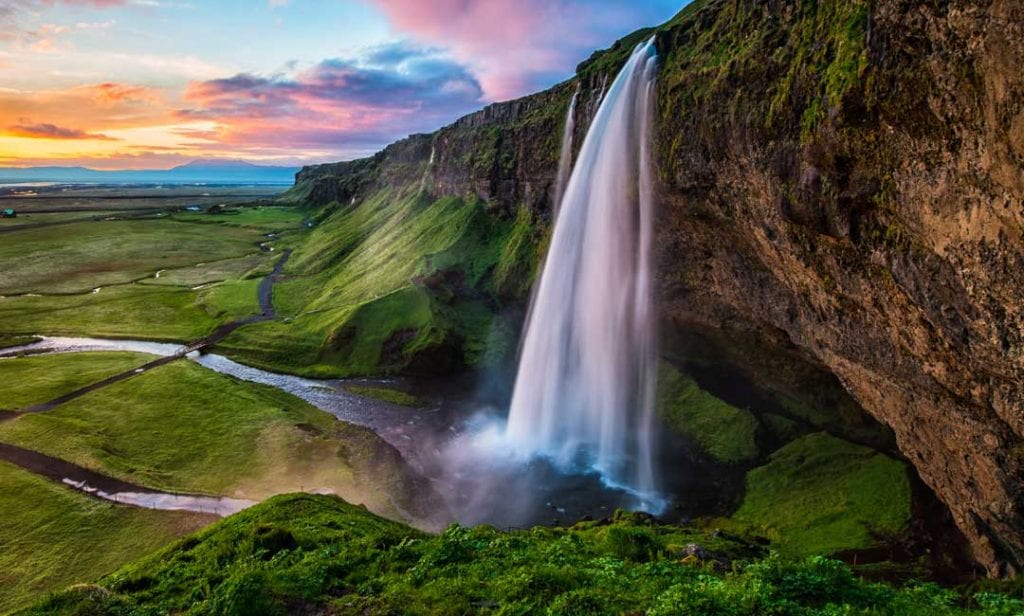
Eyjafjallajökull Glacier-Volcano
Further east along the South Coast is the Eyafjallajökull volcano which stands more than 1,650 meters tall. The awe-inspiring volcano is famous for the havoc it caused on air travel when it erupted in 2010, causing a big ash cloud. The volcano has an ice peak.
Skógafoss Waterfall
The Skógafoss Waterfall is one of the most stunning waterfalls in Iceland. It spans 24 meters, and it cascades down soaring cliffs that are 18 stories high, making for a breathtaking sight. The waterfall has been featured in different TV shows and movies, including Vikings and Game of Thrones.
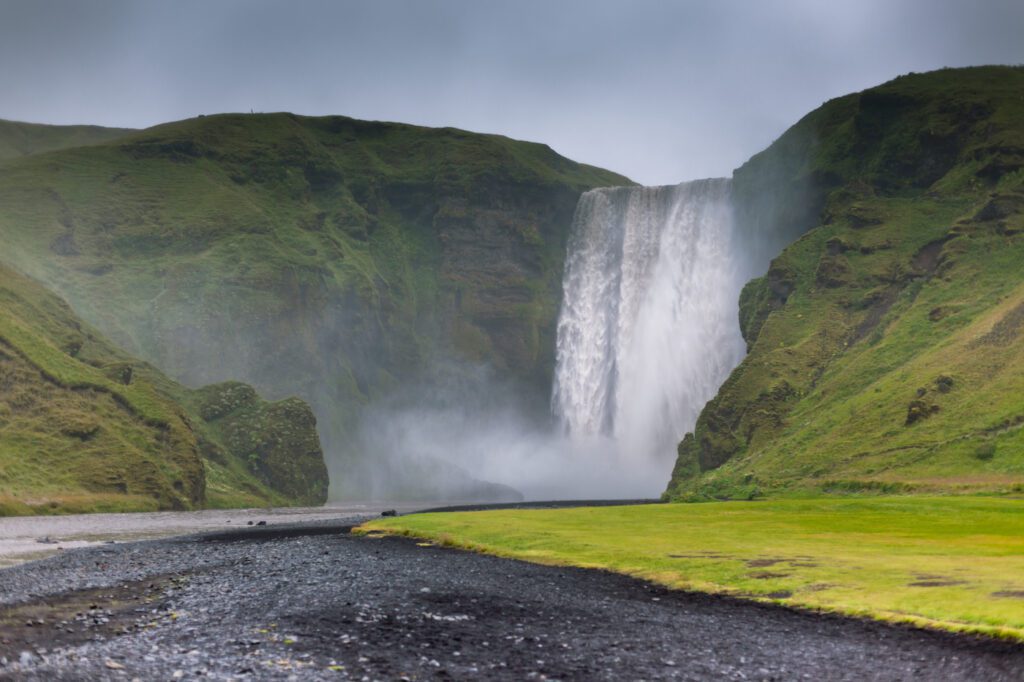
Skógar Museum
The Skógar Museum features many cultural items, artifacts, and folk displays that are related to the heritage and history of Iceland.
Seljavallalaug Pool
Seljavallalaug Pool is an artificial outdoor swimming pool that has been around since 1923, making it the oldest swimming pool in the country. It is surrounded by picturesque hills. The water is warm most of the year, remaining around 30–35°C, but too cold in the winter months.
DC-3 Plane Wreck on Solheimasandur Beach
Solheimasandur Beach features one of the more unusual sights in the Golden Circle: an abandoned naval plane. The wreckage of the US Navy Douglas DC-3 lies on the black sands of the isolated beach. The plane went down in 1973, but thankfully all the seven crew members survived.
Vík Village
Vík í Mýrdal is an important hub in South Iceland. The charming small town has diverse options for shopping, eating, and sleeping. You can walk along the black sand to see the vistas of Reynisdrangar or walk up the hill to visit the quaint church and for a brilliant view over the town.
Thingvellir (Þingvellir) National Park
The Thingvellir National Park (spelled Þingvellir in Icelandic) is usually the first stop along the Golden Circle route. This is the only place on earth where you can see the meeting of the Eurasian and North American tectonic plates above sea level. The plates are in constant motion away from each other at a rate of 2 centimeters every year due to volcanic eruptions. This has created a dramatic landscape in the National Park. You can hike along the well-maintained hiking trails. Other popular activities in the national park are diving and snorkeling on Silfra, which lies between the tectonic plates where an underground spring was disrupted by a fissure. With a visibility of 320 meters, the water here is considered to be among the clearest in the world. You also get to see the small but beautiful Oxararfoss Waterfall, which is a short hike away. The Thingvellir National Park is the only UNESCO World Heritage site on mainland Iceland.
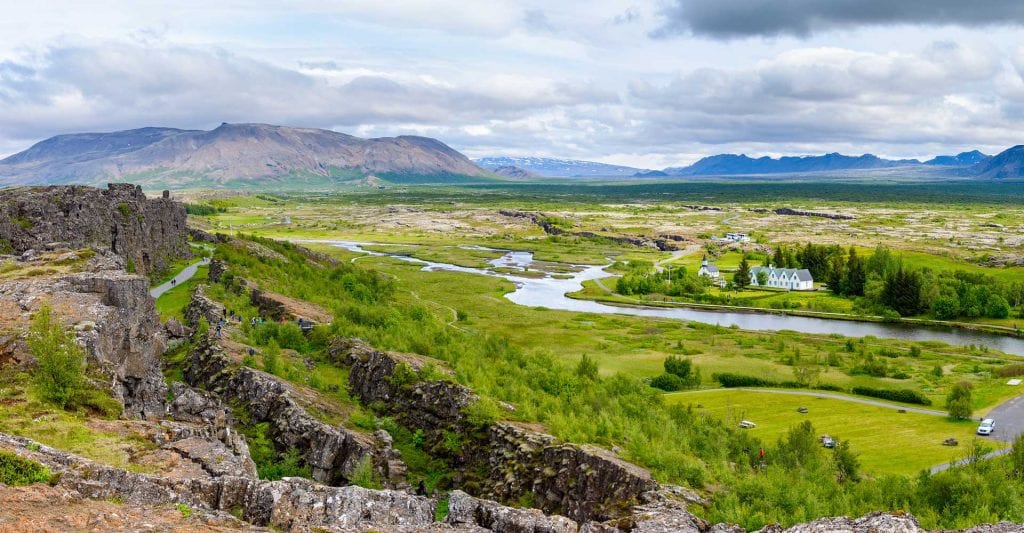
Kerið Crater Lake
The Kerið Crater Lake sits on a volcanic crater. It is characterized by red rocks and green vegetation. The lake is at the center of the crater and is at the same level as the water table. You can walk along the trail leading to the rim of the crater. Alternatively, you can take the stairs leading to the lake. The crater sits on private land, so you will pay a small fee to access the lake.
Diamond Beach
The Diamond Beach, with its crystal clear, uniquely shaped ice pieces, is simply spectacular to look at. Upstream, massive icebergs float around the Jökulsárlón lagoon and then make their way toward the channel leading to the sea. They sit here, melting until they are small enough to travel through the channel. The smaller pieces of ice are tossed around by the waves and then washed up on the black sandy beach.
Gullfoss Waterfall
Gullfoss is one of the most popular waterfalls in Iceland. Although it is hardly the tallest in the country, it is definitely vast and a sight to behold. On either side of the waterfall are large canyons. The water runs at incredible speeds over the falls, leaving tourists and locals alike in awe. If you visit during the summertime, you will enjoy the lush green surroundings and moss. In winter months, the falls are a winter wonderland. The walk from the parking lot is short. There is a viewing platform where you can get unforgettable views, but you should be careful in winter as the platform can get slippery.
Geysir Geothermal Area
The Geysir geothermal area is a must-visit if you are looking for a unique natural phenomenon. The active hot spring is located along the Golden Circle. Walking towards the area, you pass unpredictable water bursts and bubbling mud pits that leave you feeling like you are walking into another world. You should stop by the geothermal area first thing in the morning to beat the foot traffic since the area is bustling during peak season. Follow the signs telling you where you can and cannot walk to avoid getting burnt by water from the hot springs. You can hike up the hills behind the Great Geysir for a better view of the wonders below.
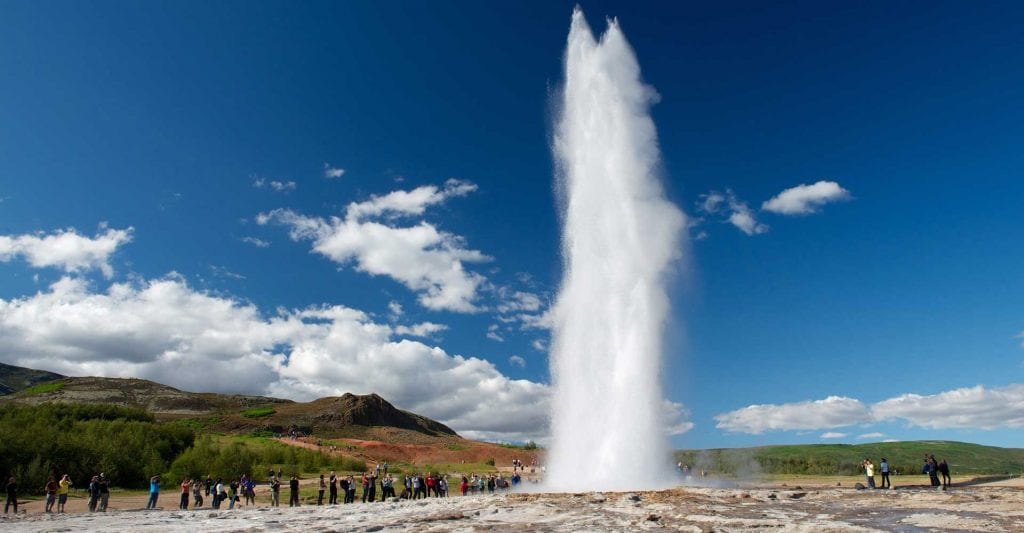
Ljosafoss Power Station
The oldest hydroelectric power station in the River Sog is Ljosafoss Power Station, having been established in 1937. Thanks to the power station, homes in Reykjavik stopped depending on coal to heat their homes and cook. Landsvirkjun, which owns and operates the power station, also has an amazing interactive museum. The exhibition showcases sustainable energy generation methods such as geothermal energy, hydropower, and wind energy. The exhibit shows guests the characteristics of electricity in a fun way and is a great stop if you are touring with your kids – plan about 30 minutes for the interactive session.
Reykjavik
Many visitors only pass through Reykjavik, the capital of Iceland, on their way from and to the airport. However, there are several worthwhile attractions in the city that is located at the southeastern corner of Faxa Bay on the Seltjarnar Peninsula. One of them is the Hallgrimskirkja Church, whose concreted stepped slabs give it its unique and iconic shape. Another attraction here is the Harpa Concert Hall which has a unique and easily recognizable façade. The concert hall is covered in curved, colored glass, giving you a beautiful view of the city from inside the hall. Finally, the Sun Voyager art installation, which is a steel structure resembling a Viking ship located next to the ocean, is also quite striking.

The Blue Lagoon
The Blue Lagoon in southwestern Iceland is arguably the most popular tourist destination in Iceland (and the most expensive). You have undoubtedly seen photos in magazines of the bright blue water set against a backdrop of black lava rocks. The lagoon is located just 45 minutes from Reykjavik. The hot water comes from a nearby geothermal plant, and its minerals are believed to be good for the skin (but not your hair, so you should lather up on a hair conditioner before entering the pool). You will need to make a reservation on the website. Once you pay the base-level entrance fee, you will get a locker, a towel, a silica mud mask, and a free drink (alcoholic or non-alcoholic) of your choice.

Skálholt Cathedral
Skálholt is a cultural and historical hub, making it a great stop if you are a history buff. Other than history and culture, Skálholt is a center of music, spirituality, education, and faith. The 700-year town receives guests all year round. The cathedral and museum are open from 9 am to 5 pm daily. The Cathedral building is beautiful and is famous for its glass-stained windows made by Gerður Helgadóttir and its powerful altarpiece made by Nína Tryggvadóttir. The windows cast a colorful light throughout the church on a sunny day. The acoustics in the church are amazing, which explains the many concerts held here. There is a restaurant in the town that opens from 10 am to 4 pm.
Kvernufoss Waterfall
Kvernufoss, another beautiful Icelandic waterfall, is similar to the more famous Seljalandsfoss in that you can walk behind it. The waterfall is much smaller, but the fact that it is also less crowded means you soak in the views more. The waterfall is located on private property, and you should stay on the trail and ensure you do not leave any trash behind. Kvernufossis located near Skógafoss, and you can combine the visit to the two. You leave your car at the Skógar Museum and walk for 10 minutes to get to the waterfall.
Solheimajökull Glacier
Solheimajökull Glacier is a popular hiking location in Iceland. The glacier is located 2 hours away from Reykjavík by car, making it popular for day trips. The hike will take 3 to 5 hours, depending on the trail chosen. At Solheimajökull, you can also choose to go ice climbing.
Dyrhólaey Viewpoint
The Dyrhólaey Viewpoint gives you an incredible view of Iceland’s south coast. From this viewpoint, you will have a great view of Reynisfjara Beach and Dyrhólaey Arch. The view along the cliffs, facing west, is simply spectacular, especially during summertime when you can see nesting puffins along the cliffs. Note that this location has two viewpoints. If you want to see the Dyrhólaey Beach and Dyrhólaey Arch, park close to the lighthouse and walk a short distance to the viewpoint. You can then take the short drive to the Dyrhólaey View Parking Lot, from where you can start your hike along the small walking trails that lead to a number of viewpoints of Reynisfjara Beach. Reynisfjara beach is a black sand beach, the color coming from residues of the volcanic activities in the area. The beach is very photogenic, with black basalt columns, rugged, black stacks of rocks, and a giant cave forming the backdrop. As with most beaches in Iceland, you should be aware of “sneaker waves” that can pull you out to sea.
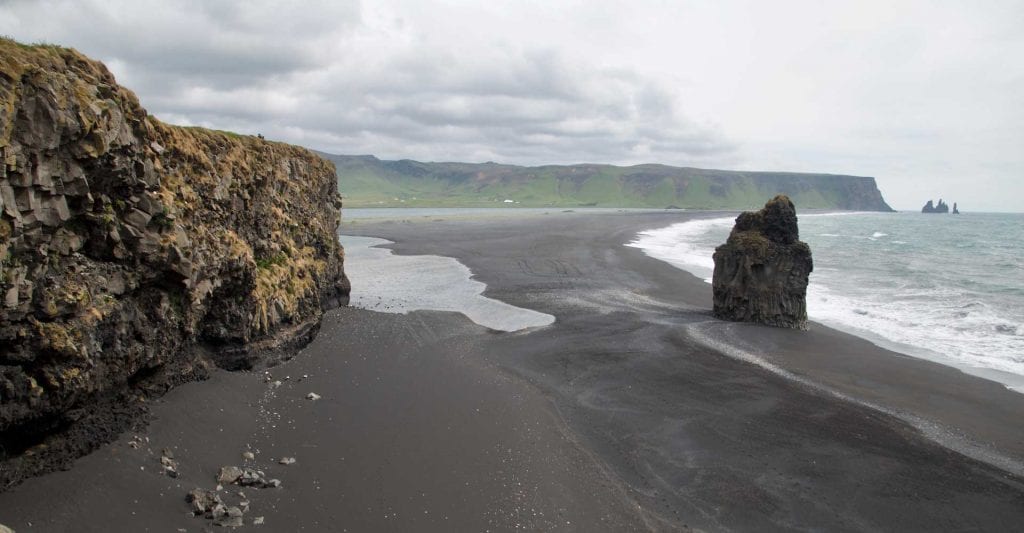
Fjadragljufur Canyon
Fjadragljufur is hard to mouth – it means “Feather River Canyon.” This is one of the best spots to take photos in Iceland. There is a 2-kilometer hiking trail that scales one edge of the canyon and offers magnificent sights of the river below. To access the Fjadragljufur Canyon, you will need to drive a bit of a distance on a passable dirt road (no 4×4 is necessary).
Svartifoss Waterfall
Svartifoss is a unique waterfall that is the inspiration for the design of the Hallgrimskirkja church in Reykjavík. It features a thin stream of water washing over black volcanic basalt columns, which makes it extremely photogenic. The waterfall is located in Skaftafell Nature Park. You must hike uphill from the Skaftafell visitor center to access it. The 3-kilometer round trip takes around 1 ½ hour.

Vatnajökull Glacier in the Vatnajökull National Park
Iceland, the land of fire and ice, has world-famous glaciers. Located in the Vatnajökull National Park is the Vatnajökull glacier, the biggest protected area in Europe. Covering an area of 8,400 square kilometers (3,200 square miles), the glacier has an average ice thickness of more than 900 meters (3,000 feet). The glacier has about 30 outlet glaciers in the form of long ice tongues reaching out from the large glacier. There are several active volcanoes throughout the ice field, with the meltwater feeding hundreds of rivers, the largest being Thjórs, Jökulsá á Fjöllum, Skjálfandafljót, and Jökulsá á Fljótsdal. The ice floating in Jökulsárlón Glacier Lagoon and flowing down to the Diamond Beach originates from the Breiðamerkurjökull outlet glacier of the Vatnajökull Glacier. This is one of Iceland’s best glacier-hiking spots. The distance from Reykjavik, and the various outlet glaciers available to hike, means the glacier is not crowded.
Another notable feature of the extensive Vatnajökull National Park is Hvannadalshnúkur. Standing at 2110 meters, this is the topmost point in the country. Enjoy hiking to the summit if you have the time in the presence of a guide.
Fjallsárlón and Jökulsárlón glacier lagoons
Fjallsárlón glacier lagoon is free and quick to visit. There is a restaurant and restrooms available, making it a great stop on your south Iceland tour. The Jökulsárlón Glacier Lagoon is larger and has more tourists than the Fjallsárlón glacier lagoon, but the former is more beautiful. It is easily accessible as you simply have to drive up, park, and soak up the view. However, kayak tours and zodiac rides in the lagoon are available for those who want more adventure.
Höfn
Höfn is mainly a fishing village and a charming capital city of southeast Iceland. It makes for a great base when exploring South Iceland. The Höfn Swimming Pool is basically a waterpark comprising different hot tubs of varying temperatures and an ice plunge for the brave at heart. You can sleep at the Milk Factory or the Apotek Guesthouse and eat at the Pakkhus Restaurant, Otto Restaurant, or the Ishusid Pizzeria.
The Stokksnes Peninsula
The Stokksnes Peninsula is a wild and photogenic peninsula in South Iceland. Towering from its sandy beach is Vestrahorn, a mountain with the shape of a wing christened “Batman Mountain.” Capturing Vestrahorn with the bumpy sand dunes that are engulfed in grasses and the sandy beach makes for stunning photos, especially at high tide. To access the beach, pass through the Viking Café Guesthouse in Höfn and submit the admission fee.
Dverghamrar (Dwarf Rocks)
Dverghamrar is a protected natural monument located just east of Foss and some 10 kilometers east of the Kirkjubæjarklaustur village. This is a peculiar and beautiful columnar basalt formation. There is cube-jointed basalt on top of the columns. The landscape is believed to have been molded at the end of the last Ice Age. The peculiar-looking rocks are believed to have been a result of wave activity since the sea level was higher at the time.
The choices are many. For the best experience, go for a guided private tour in Iceland to ensure you get a customized package based on your particular needs. At Deluxe Iceland, we are a fully authorized luxury travel agency and tour operator, offering clients private tours and self-drive tours that are designed by our team of local experts. Contact us today if you want to experience the best of Iceland.
